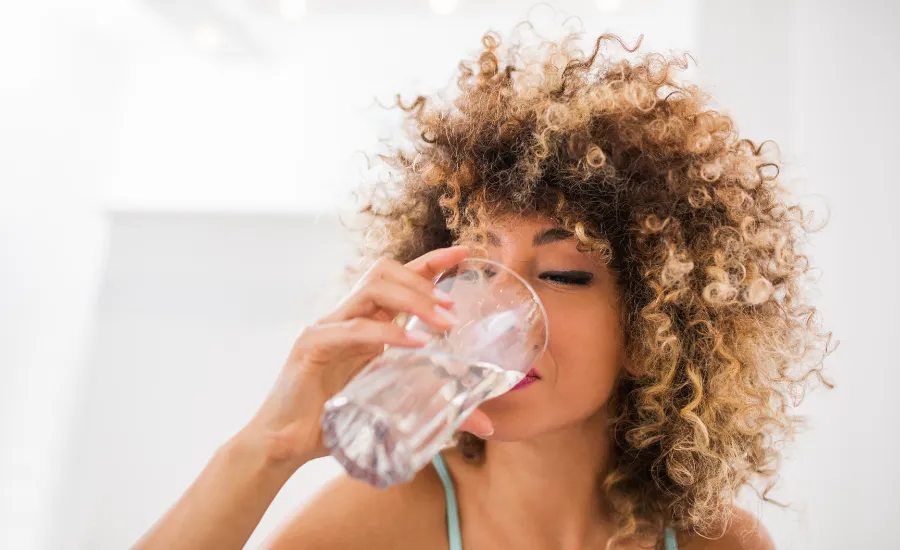
Why Water is the Ultimate Beauty Elixir
We are all aware that water is considered by many specialists to be the top beauty elixir.
Nutritionists, physicians, fitness experts, and beauty coaches swear on its benefits. By drinking more water, we reap the benefits of improved hydration and the good things that come with it.
Moreover, drinking more water helps our body eliminate toxins, move nutrients to skin cells, and keep skin soft and elastic. Plus, when you drink plenty of water, your body can do all these functions better, leading to clearer, healthier skin.
However, sometimes thinking that you have to drink so much water during the day can be challenging and, quite impossible. Also, a lot are wondering whether water is actually that effective.
What happens to your skin when you start drinking more water?
Rachel Liverman, the CEO and founder of Glowbar explains that “Skincare begins and ends with drinking water! And it can do wonders for your skin!”
Given that our skin is made up of a significant amount of water, around 64%, when we don't drink enough, this reflects on our skin. Dehydrated skin looks dull, flaky, and loses elasticity. Proper hydration plumps up the skin cells, giving our face a more youthful and radiant appearance.
Staying properly hydrated can also reduce puffiness and swelling, particularly around the eyes, by balancing fluid levels and reducing water retention. In particular, for people with oily skin, drinking enough water can help balance oil production, preventing the skin from becoming too oily or too dry. Also, adequate water intake helps maintain the skin's elasticity, which is what keeps it looking firm and youthful. Dehydration can cause wrinkles and fine lines to become more noticeable. Is there anything more to say?
How long does it take for drinking water to improve skin?
According to Liverman, people will usually notice the beneficial results of water intake in their skin in a few weeks to a month. “This gives your body time to adjust and can improve skin moisture, elasticity, and overall appearance,” she says. “But, keep in mind that individual results can vary depending on factors like your baseline hydration levels, overall health, diet, and what else you are incorporating into your skincare routine.”
As for the key takeaway, nurse practitioner and aesthetic specialist Limor Weinberg adds, “Like anything else, consistency is key to seeing results.”
Does drinking too much water have any negative effects on the skin?
About a gallon daily intake is a good amount of water. But can too much water actually be bad for the skin? The answer is essentially no. “In some rare cases, drinking too much water can disrupt the electrolyte balance and cause a condition called hyponatremia, which is basically a drop in the sodium levels in your blood,” explains Weinberg. “Sodium is an essential electrolyte and is responsible for proper heart function and fluid balance in the body.” To avoid this, try not to drink too much water in a short time span and try to spread out the intake throughout the day.
How to drink a gallon of water a day
As we mentioned before, drinking such an amount of water daily sounds intimidating, but, in reality, it’s not as much as you might think.
The first step in increasing your water intake is to start your morning with a large glass of water as soon as you wake up. This will kickstart your hydration journey and get you ready for what’s to come. Also, taking into consideration the fact that our body is fully dehydrated after 8 or so hours of sleep, you can imagine what a gift this would be. From there, try drinking two glasses of water every hour.

A clever trick is to use technology on your benefit. Set alerts on your phone or use a water tracking app to remind yourself to drink throughout the day. By nighttime, you should be well-hydrated and most definitely hit the gallon mark.
Another very effective trick is to use a gallon-sized water bottle. This way, you can monitor your water intake more accurately and also you will know exactly where you are throughout the day!
Also, in case you feel like you don’t want to taste water that much, you can always add slices of fruits like lemon, cucumber, or berries to your water for a refreshing twist.
Finally, you can always “eat your water”: Fruits and vegetables with high water content like watermelon, cucumber, celery, and leafy greens can also contribute to your daily fluid intake, so why don’t you add some celery to your green salad?






